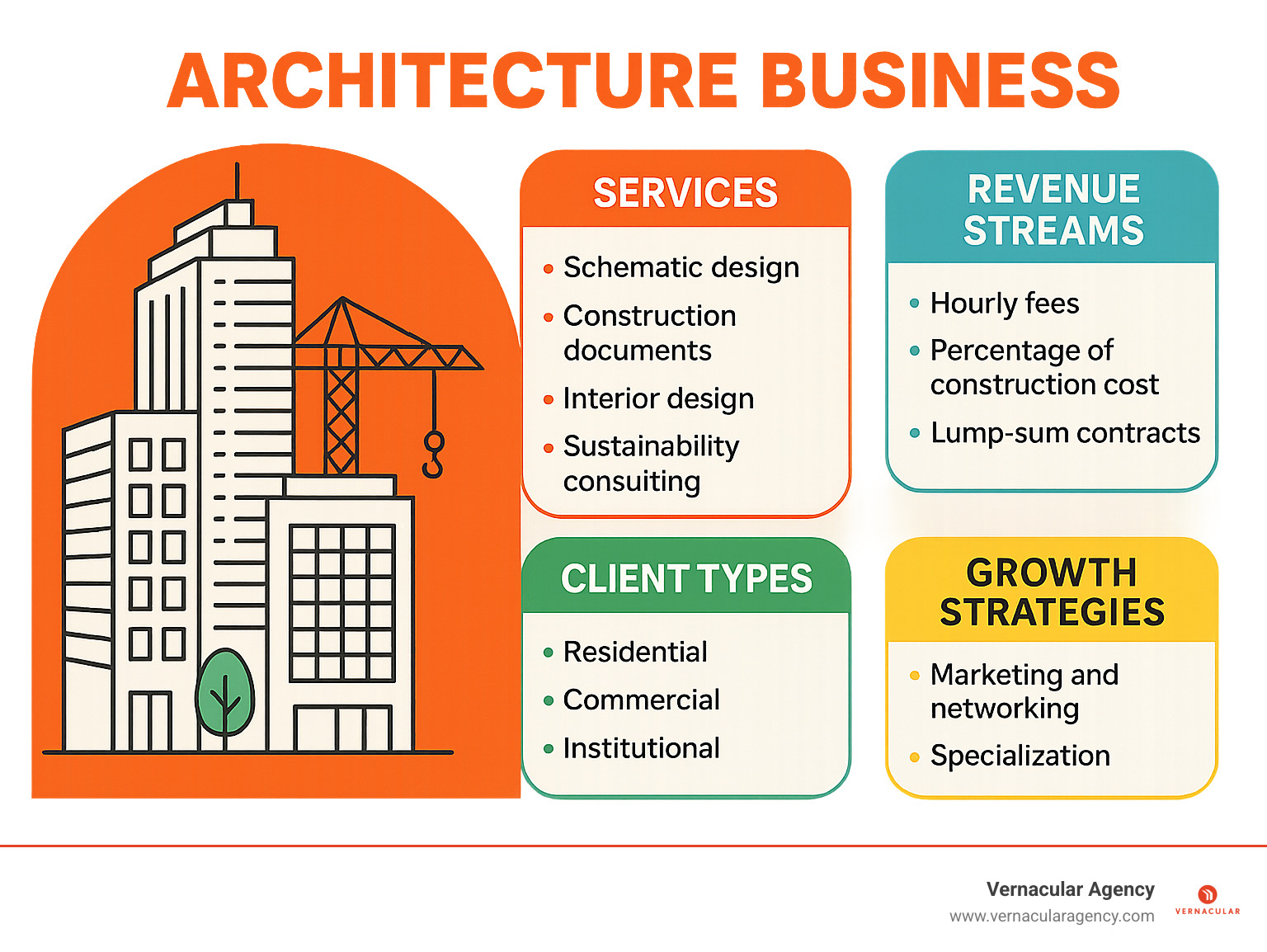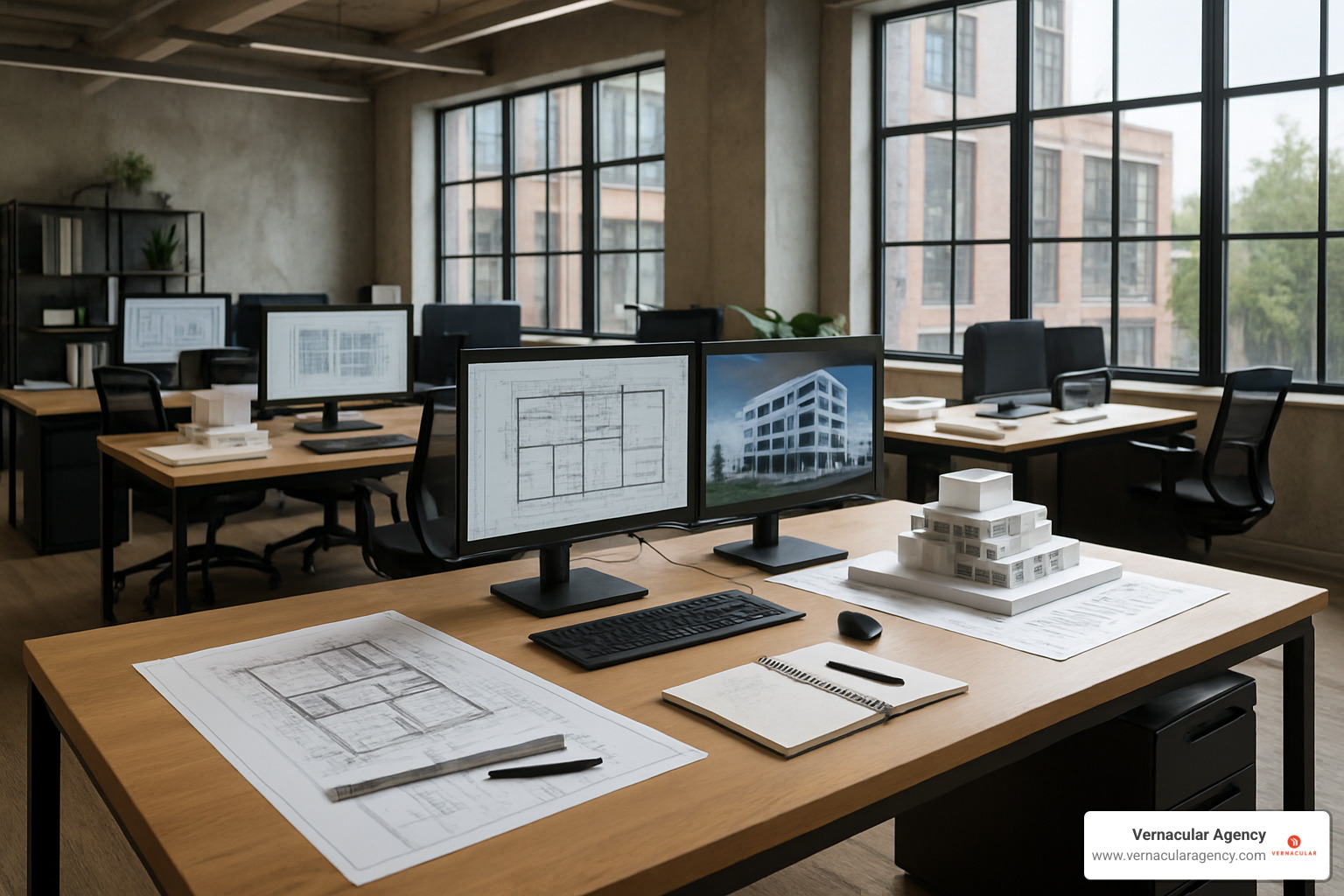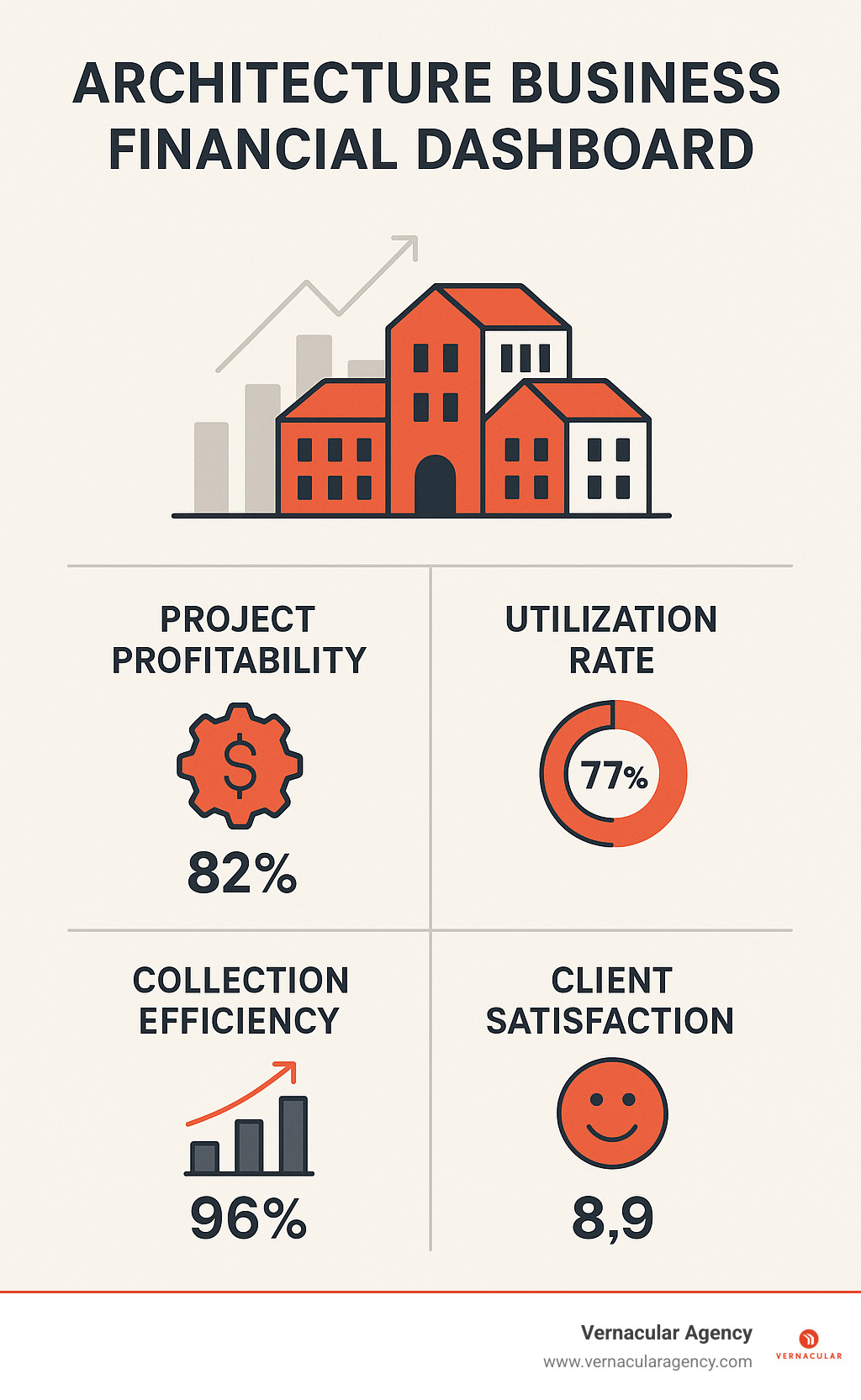An architecture business is a professional service firm that provides design, planning, and project management solutions for residential, commercial, and institutional buildings. These businesses combine creative vision with technical expertise to deliver everything from initial concept sketches to construction administration.
Key Architecture Business Components:- Services: Schematic design, construction documents, interior design, sustainability consulting- Revenue Models: Hourly fees, percentage of construction cost, lump-sum contracts- Market Growth: 4.8% compound annual growth rate projected through 2030- Business Types: Sole proprietorships, partnerships, corporations, multi-disciplinary firms
The architecture services market is experiencing strong demand driven by construction activity, sustainable design requirements, and digital change. However, success requires more than design talent - it demands understanding business fundamentals, client acquisition strategies, and operational efficiency.
Most architects receive extensive design education but little formal business training. This gap creates both challenges and opportunities for those willing to master the business side of architecture.
I'm Rebecca Falzano, Creative Director with nearly 15 years of experience guiding content creation and brand development for design professionals. Throughout my career working with architects and design firms, I've seen how mastering architecture business fundamentals separates thriving practices from struggling ones.

Running a successful architecture business offers tremendous rewards: creative independence, flexible schedules, and the ability to shape communities through design. The demand for architectural services remains consistently high, especially in areas with substantial construction and development activities.
This guide provides the comprehensive roadmap you need to build and scale a thriving architecture practice, combining industry insights with practical business strategies.
The architectural services market is expanding at a steady 4.8% compound annual growth rate through 2030, driven by urban expansion, modern workspace needs, and demand for sustainable buildings. Specialized services like healthcare facilities, educational buildings, and mixed-use developments show particularly strong growth.
The scientific research on architecture services market shows these specialized markets often command higher fees, making them attractive targets for firms ready to develop niche expertise.
An architecture business is a professional problem-solving practice that translates client dreams into reality, steers complex regulations, and manages projects from concept to completion. Unlike businesses that sell products, architecture firms sell expertise - your knowledge, creativity, and ability to solve spatial challenges.
The most profitable architecture businesses position themselves as strategic partners and trusted advisors. Revenue typically comes through professional fees - either hourly rates, percentages of construction costs, or fixed project fees structured to reflect the true value you provide.
Modern clients expect comprehensive solutions from architecture firms:
Design services include schematic design, design development, and construction documents. Technical expertise like Building Information Modeling (BIM), sustainable design knowledge, and LEED certification capabilities are now standard requirements.
Project management and construction administration help clients steer the construction process. Specialized consulting in areas like historic preservation, feasibility studies, and performance optimization often command premium fees.
Sustainability has moved from nice-to-have to must-have. Clients increasingly demand net-zero buildings and designs supporting circular economy principles. Firms developing deep expertise in sustainable design gain significant competitive advantages.
Technology is revolutionizing everything through digital twins, virtual reality client presentations, AI-streamlined processes, and cloud-based project management. Remote collaboration has permanently changed how firms operate internally and work with clients and consultants.
Starting an architecture business requires careful planning and attention to legal, financial, and operational details. The decisions you make early will shape your long-term success.
You'll need your professional architecture license in every state where you plan to practice, business entity registration, and an Employer Identification Number (EIN). Essential insurance includes both professional liability and general business insurance. Check local requirements for business permits, zoning compliance, and Certificate of Practice requirements.

Your business plan guides every major decision. Include a compelling executive summary capturing your unique value proposition, detailed target market analysis understanding your ideal clients, thorough competitive analysis identifying market gaps, and realistic financial projections for at least three years.
| Business Structure | Advantages | Disadvantages | Best For |
|---|---|---|---|
| Sole Proprietorship | Simple setup, complete control, tax benefits | Unlimited liability, limited growth potential | Solo practitioners, low-risk projects |
| Corporation | Limited liability, easier to raise capital, professional credibility | Complex setup, double taxation, regulatory requirements | Growing firms, multiple partners |
| Partnership | Shared resources, complementary skills, moderate complexity | Shared liability, potential conflicts, complex dissolution | 2-3 partners with aligned goals |
Stay current with professional standards, building codes and zoning regulations, and copyright protection for your designs. Implement quality control processes, document everything, and maintain adequate professional liability coverage.
Technology infrastructure requires $3,000 to $8,000 for professional-grade computers and monitors, plus $2,000 to $5,000 annually for software licenses. Professional services cost $2,500 to $5,500 for legal and accounting setup. Insurance premiums range from $3,000 to $8,000 annually. Plan for $20,000 to $50,000 in working capital to cover expenses during payment cycles.
Choosing the right business model defines who you are as a firm and how you'll compete. Your model shapes everything from staffing decisions to marketing strategies.
Efficiency-based firms focus on doing similar projects quickly and well, leveraging standardized processes for higher volumes with predictable outcomes. Think chain restaurants or apartment complexes where speed and reliability matter most.
Experience-based practices win projects through proven track records and portfolio strength. These firms compete through RFPs and maintain relationships with repeat clients, typically working on hospitals, schools, and institutional projects.
Expertise-based firms command premium fees by offering unique capabilities clients can't find elsewhere. These practices focus on thought leadership and industry recognition, specializing in areas like historic preservation or cutting-edge sustainable design.
Your brand communicates what makes your architecture business different through every client interaction. Start with clarity about what you do best and who you serve, then maintain visual consistency across all materials.
Your website serves as your always-available portfolio and business development tool. Potential clients will research you online before making contact. For detailed guidance on creating an effective web presence, check out our comprehensive Website Design for Architects resource.

Invest in quality architectural photography that shows your work in the best light. Poor photos can make even excellent projects look mediocre.
Referrals remain the most powerful marketing tool. Create systems for maintaining relationships with former clients, consultants, and contractors. Networking through professional organizations builds visibility within your target market.
Digital marketing has become essential for reaching decision-makers who research everything online. Focus on being found when potential clients search for architectural services. For comprehensive strategies, explore our guide on Digital Marketing for Architecture & Design Studios.
Content marketing works well because you have built-in stories through your projects. Share insights about sustainable design trends, zoning changes, or construction factors that affect client decisions.
Running a profitable architecture business requires mastering business fundamentals alongside design excellence. The most successful firms track key performance indicators like project profitability, staff utilization rates, payment collection speed, and client satisfaction scores.

Hourly billing offers flexibility when clients change their minds but requires careful time tracking. Percentage of construction cost (typically 5-15%) ties your success to project success. Lump-sum contracts provide budget certainty but require accurate upfront scoping.
Smart cash flow management includes invoicing promptly, establishing clear payment terms with penalties, requiring retainers from new clients, and maintaining 3-6 months of operating expenses in reserve.
Building Information Modeling (BIM) has become essential, reducing errors and speeding documentation. Cloud-based project management tools keep teams coordinated regardless of location. Don't overlook professional accounting software and CRM systems.
Emerging technologies like virtual reality help clients visualize spaces, artificial intelligence assists with design optimization, and drone photography makes site analysis faster and more accurate.
Service diversification can increase revenue per client through interior design, sustainability consulting, or construction management. Geographic expansion opens new markets with different economic conditions. Strategic partnerships accelerate growth while sharing risk.
For detailed strategies on improving search engine visibility, check out our guide on SEO Strategies for Architects.
Building a successful architecture business requires continuous learning and adaptation. The most successful architects invest in both design skills and business knowledge, staying ahead of industry trends while building stronger practices.
Professional organizations like the American Institute of Architects (AIA) offer networking opportunities and industry insights beyond continuing education credits. The Business Architecture Guild provides specialized resources including external webinar link covering financial management and strategic planning.
Business education fills critical gaps through MBA programs, executive education, or specialized training for design professionals. Specialized certifications like LEED accreditation or WELL Building Standard demonstrate expertise that commands premium fees.
Smart succession planning strengthens your firm today while protecting future options. Begin planning 5-10 years before intended transitions. Options include internal succession to employees, Employee Stock Ownership Plans (ESOPs), strategic sales to larger firms, or management buyouts.
Building a transferable business requires documenting processes, developing strong management teams, and maintaining detailed financial records.
Sustainability leadership represents both professional responsibility and business opportunity. Climate action requirements create demand for firms with expertise in net-zero design and renewable energy integration.
Technology integration should focus on tools that solve real problems rather than adding complexity. Future-ready skills include interdisciplinary collaboration, data-driven design, and client experience management.
Most architecture businesses take 12-24 months to see consistent profits. Efficiency-based firms often reach profitability quicker through low overhead and standardized processes. Expertise-based firms might take longer but achieve higher margins.
Factors affecting profitability include initial client base, working capital, fee structure, payment collection efficiency, and market conditions.
Professional liability insurance is most critical, typically requiring $1-5 million coverage depending on project size and risk. General liability insurance covers everyday accidents. Property insurance protects office equipment and technology investments.
If you have employees, workers' compensation insurance is typically required. Cyber liability insurance is increasingly important for firms storing client data digitally.
Joint ventures with larger firms or specialists leverage complementary skills. Specialized expertise in areas like historic preservation can level the playing field. Exceptional service through personal attention and quick responses often outweighs firm size.
Strategic relationships with established consultants and contractors provide credibility. Portfolio development through smaller projects systematically demonstrates capability for larger work.
Starting and growing a successful architecture business requires careful planning, solid foundations, and attention to both design excellence and business fundamentals. With the architecture services market growing at 4.8% annually through 2030, there's real opportunity for firms that master both creativity and commerce.
The most successful architecture firms treat their business operations with the same care they bring to design work. They understand that great architecture starts with great client relationships, invest in the right technology and systems, and never stop learning and adapting.
Your creative talents got you into architecture. Your business skills will determine how far you can take your practice. At Vernacular Agency, we've worked with countless design professionals who understand that building a strong brand is just as important as building strong structures.
If you're ready to build not just beautiful buildings, but a beautiful business, we'd love to help. Our Brand Identity Services are designed specifically for creative professionals who want to stand out in today's competitive marketplace.

The future belongs to architects who master both sides of the profession - those who can create inspiring designs while running profitable, sustainable businesses. Your architecture business journey starts with treating your practice with the same creativity and attention to detail you bring to every project.